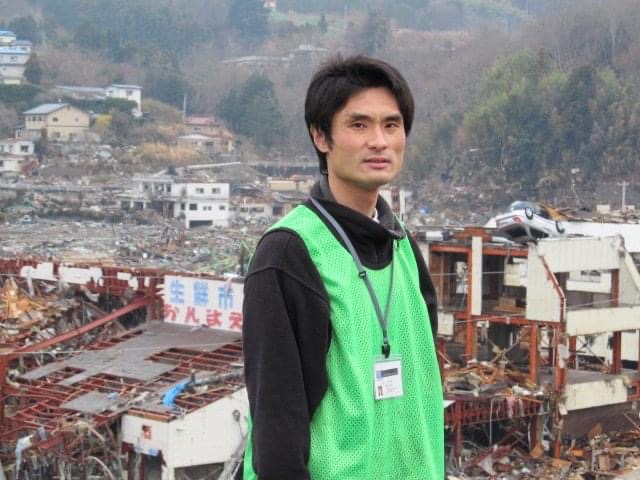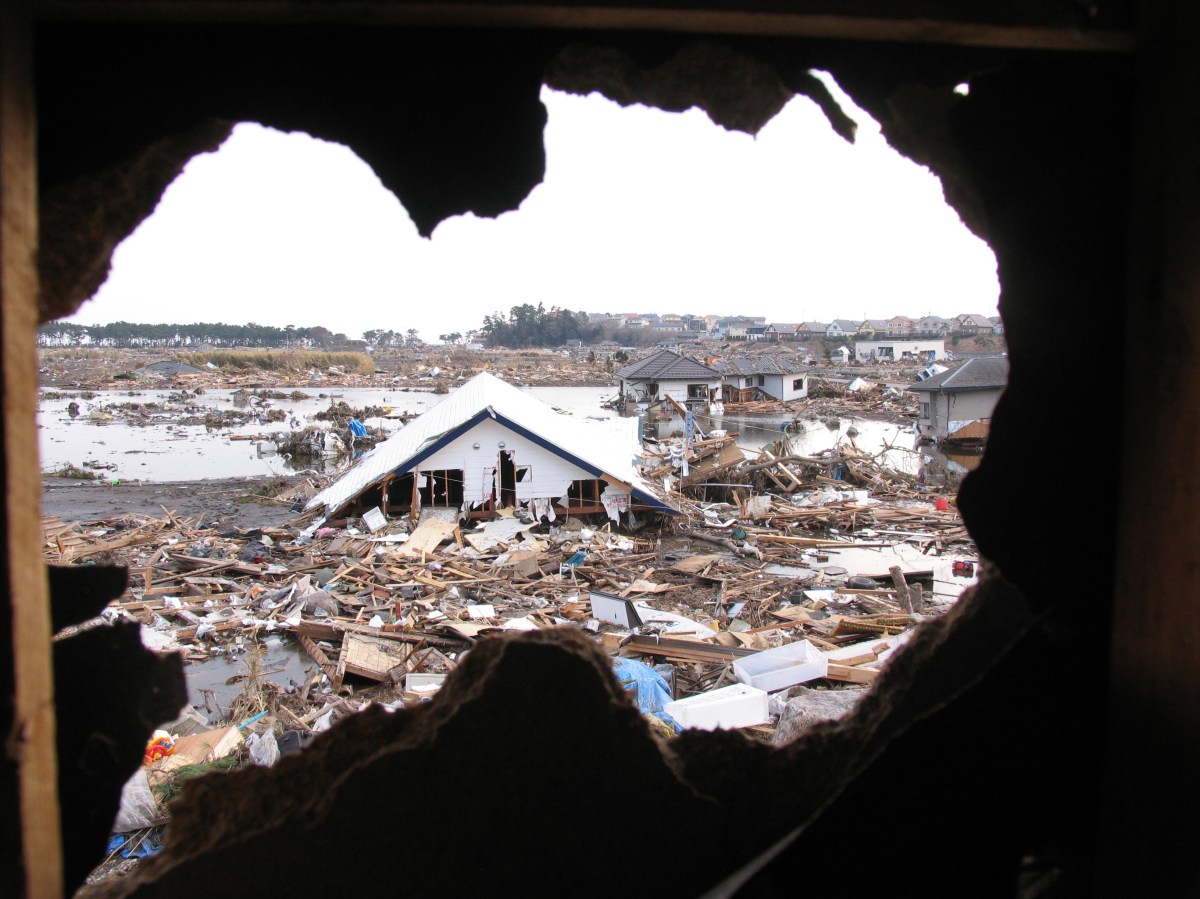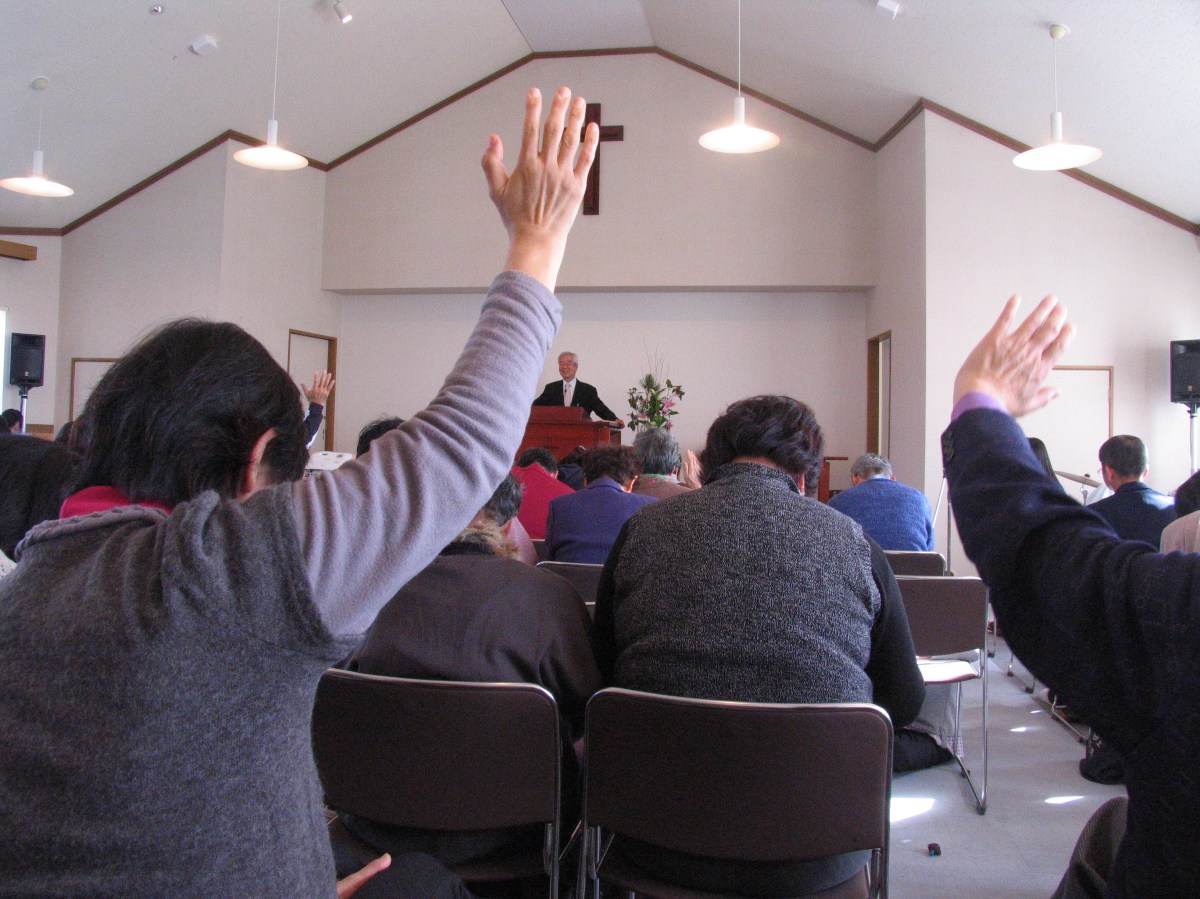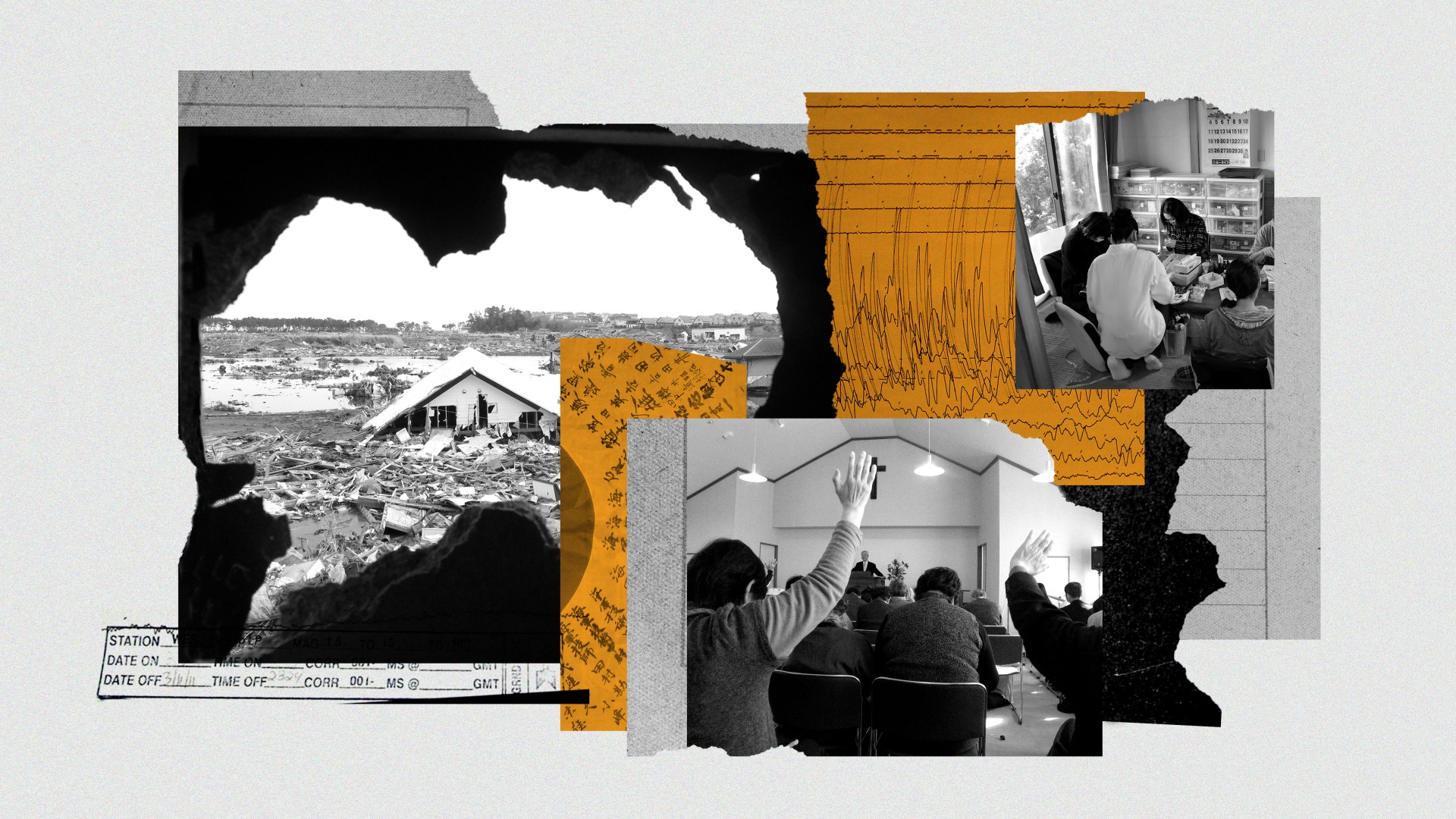On February 13, almost 10 years to the date after the infamous March 11 triple disaster that struck northeast Japan, a 7.3-magnitude earthquake shook the same region.
Like a strobe light, memories and emotions that had been dimming for a decade returned. However, the aftershock was not just a reminder of the devastation and 20,000 deaths from 2011’s 9.0-magnitude earthquake in the Tohoku region and resulting 45-foot tsunami and nuclear disaster in Fukushima. It also prompted the Japanese church to call to mind all that God has done since.
Pastors and ministry leaders in Japan told CT of how the disaster has shaped the Japanese church and where they are headed next, providing a perspective of hope and urgency for churches worldwide amid the trials of the pandemic and current conflicts.
Shaken and Stirred into Action
For Yoshiya Hari, the triple disaster marked an almost immediate career and life change. Within days, the pastor of Saikyo Nozomi Chapel was assigned to help run CRASH (Christian Relief Assistance Support and Hope), organizing and allocating the masses of donated material and volunteers that were suddenly flooding into Tohoku from Taiwan, Singapore, the Philippines, the United States, and other nations.
“I was so overwhelmed. I was just a local church pastor and suddenly I was here,” said Hari, also Asian Access’s national director for Japan since 2011. “The news was broadcasting shocking scenes: the tsunami, the nuclear reactor explosion in Fukushima. There was so much fear and it felt like trials were hitting us like waves that keep coming and coming. Japan seemed almost at its end.
“But we realized that people all over the world were praying and sending support and we were encouraged,” he told CT. Organizations like CRASH helped mobilize relief efforts in Tohoku and, more importantly, established support networks of pastors and ministers across Japan that have continued for the past decade.
“Relief has its time limits,” said Hari. “But the local church has an eternal commitment.”

Japanese pastors agree that in many ways the disaster in Japan has been a catalyst for positive change.
“The spiritual atmosphere has changed and people are more open to the gospel,” said Nobuyoshi Nagai, lead pastor of Tohoku Central Church and Japan’s national director for Alpha. “Churches from all over Japan and the world now have a desire to come to Tohoku to evangelize and plant churches. Many people have accepted Christ and many churches have been planted since the disaster.”
“Small communities in the northeastern disaster area that had been notorious for limited receptivity to the gospel before 2011 have now recognized the presence and importance of the church,” said Takeshi Takazawa, a church planting veteran who currently serves as Asian Access’s vice president for innovative initiatives.
“We’ve also seen more connections within Asia,” he said. “For example, the Love Singapore movement has embraced Love Japan, and the Filipino church has a strong relationship with Japanese churches.”
Churches in Japan also now feel better prepared to address new disasters and social issues. When a large earthquake struck Kumamoto in 2016, Christians from Tohoku immediately connected with leaders there to share about their experiences and advise the response.
Prepared for Pandemic
COVID-19 has brought about challenges for the recovery effort in Japan, including drawing government and media attention away from any tsunami recovery efforts in the northeast. But the church has been able to use wisdom gained after the disaster to offer help during this new crisis.
Support methods such as pastor networks and crisis management plans that were created in relief efforts have been reactivated nationwide this year to support those in need. Establishing networks and building local community trust were necessary in addressing both the 2011 disaster and the 2021 pandemic.
“Networks we had set up in 2011 allowed us to share ideas and wisdom in the midst of the pandemic, and since we had built trust with the community and local government after the tsunami, people sought help from churches during the pandemic,” said Yukimasa Otomo, pastor of Shiogama Bible Baptist church in a small fishing town between the large cities of Sendai and Matsushima. For example, his church provides food for those who have lost their jobs or working hours amid public health measures.

“All Japanese were impacted in some way by the disasters in 2011. For some, it may be just a superficial change, but for others, including pastors and churches, it has caused deep and significant changes,” said Hari. “I pray that the pandemic causes similar deep changes in us—including myself.”
“Japanese Christians are once again re-examining what it is to be a disciple of Jesus Christ because of the pandemic,” said Takazawa. “The church has moved out of the ‘come in’ mindset to be more missional.”
The increased sensitivity to outsiders and commitment to holistic care prompted several churches to reach out to internationals who came to Ishinomaki for fishing jobs and were stranded with limited options or made to work harder to make up for factories losing workers because of COVID-19.
Let the Walls Fall Down
Many people came into contact with Christians for the first time through their presence after the 2011 disaster. The Japanese church consequently learned to go beyond its walls and to serve people physically and emotionally as well as spiritually.
“They learned that its task is not only to proclaim and persuade, but to communicate the gospel through acts and to meet the social needs in front of them,” said Takazawa.
This holistic approach to the gospel in Japan is an exciting development growing from the seeds of disaster, sources told CT.
“We’re starting to sense a greater awareness of the needs of those ‘on the outside’ who often remain invisible or do not have as much of a voice at the table, like women, those with disabilities, foster and adopted children, and immigrants,” said Sue Takamoto. She and her husband Eric serve with Asian Access on a team in Ishinomaki, one of the worst-hit areas, and have created a community with other international Christian workers from a variety of organizations. They moved into a rural area where there was no local church to try to live out the gospel there, and ended up helping to plant a new church.
At the very least, pastors agree that the massive disaster brought issues to light and challenged the church in Japan.
“Some people realized how out of touch their churches were with their communities, others that they did not have the proper vocabulary to explain the gospel to rural Japanese people with no Christian background,” said Makito Matsuda. Born in Miyagi Prefecture, where more than 10,000 people lost their lives in the 2011 earthquake, the pastor hosted 15,000 volunteers from all over the world at Oasis Chapel Rifu, providing much-needed relief in the tsunami-affected areas around his church.
“Some, like myself, realized that serving in unity with Christians from other parts of the world with different languages and cultures can have a great impact on the community,” said Matsuda. “Prompted by these realizations, we gradually began to change.”
A common opinion among pastors is that the post-disaster networking has caused the Japanese church to be more unified than ever.
“I have seen churches across denominations coming together for training, but it was not until after 2011 that I saw such a unified effort for the sake of the suffering and those in need,” Takamoto said. “While the immediacy has lessened in recent years, I don’t think this desire for unity has dissipated.”
Denominational divides were a huge issue prior to the disaster, and although the walls between churches and communities have been torn down, there is still much work to be done in bridging the gaps.
“Networks are beautiful, but hard to maintain,” said Otomo.
“We need to cultivate a better kingdom mindset and develop appreciation for diversity within the body of Christ for the mission to accelerate,” said Nagai.

Hope Beyond Relief
Neighborhoods remain lost, scattered, or neglected even 10 years after the tsunami, so current ministry has shifted from immediate relief to building relationships and community. Many leaders have taken to creative, entrepreneurial community-building solutions.
For example, The Nozomi Project emerged from the disaster to provide a space for women to find dignity, employment, and hope as they created beautiful jewelry out of broken shards of pottery. “Amid setbacks and challenges of keeping a business afloat, I have realized that when God breathes into projects, they can become much bigger than ourselves,” said Takamoto, who directs the project which has now sent more than 60,000 “pieces of hope” to more than 45 countries.
For the past two years, Nozomi has also been serving a group of vulnerable women in Cambodia. “It’s been one of the most amazing experiences of my life to see former tsunami victims reaching beyond themselves to bring hope to women in Cambodia with needs greater than their own,” said Takamoto. “Whether they recognize it yet or not, this is the gospel, and it is beautiful.”
Beyond survival and recovery, church networks discovered a need to refocus on reaching the unreached. The tsunami destroyed five Tohoku churches, which was a small statistic in comparison to the $250–$500 billion worth of damage wreaked on Japan. But it was a wake-up call for Japanese pastors. It proved how few churches had been planted along the coast.
“We had to repent once we realized it,” said Hari. “It was not intentional, but those people were abandoned. These were, for the most part, unchurched areas that had slid out of our sight.”
Today, Asian Access estimates that 75 congregations, including 33 house churches started by a single pastor in Miyagi, have been planted in the area since the disaster.
There is social division between Fukushima and the rest of Japan, and even within Fukushima due to the radiation and the scattering of communities caused by the power plant meltdown. The government may take more than 50 years to fully decommission the reactor, and although radiation levels are much safer, hardship and stigma linger.
“I’m really concerned about Fukushima, especially the next generation that has to deal with the same issues,” said Hari. “After the disaster, hundreds of missionaries flocked to Miyagi and other areas affected by the tsunami, but very few to Fukushima. We know there was risk, but we hope people can overcome the fear and the stigma and come. That is where there is a huge need.”
From Tohoku to the World
In addition to reflecting on their post-disaster church, the network of Japanese pastors provided advice for their brothers and sisters around the world on preparing for and responding to disasters as leaders.
Matsuda admitted that his team felt overwhelmed, overworked, and anxious at first. “What gave me life again was to return to a rhythm of sitting at the Lord’s feet, listening to his word, and obeying it. I now believe that a steady commitment to this way of life is the only way to prepare for unexpected disasters and survive in the midst of chaos.”
Nagai urged leaders to “be open to being changed. Whether COVID-19 or a tsunami, no one is exempt from change in a crisis. God is constantly looking for his ‘new wine skin’ to work with, and he sometimes uses a disaster or trial to form us into that vessel.”
“Church leaders should all consider responding to a disaster now,” said Otomo. “It is too late to think about it after the disaster. If your church has a clear vision on this matter, you will be ready to respond. If not, it will be difficult to maintain good works when times like this come. Once you’ve decided it is important, building your local church network is the first step.”
“We must see disaster and crisis as normal and not as something that catches us by surprise,” Takazawa said. “Leaders tend to see the period of time without crisis or disaster as normal, so crisis becomes something to just get through or something outside of God’s control. But God is always working in the crisis and Jesus warned that they will even intensify.
“It is also important to listen to the people who were there from before the crisis and who will still be there when it has gone,” he said. “God has already placed leadership within that community, so if you are going to help as an outsider, listen to, support, and serve local leadership.”
The Next 10 Years
On the 10th anniversary of the triple disaster, Japanese churches continue allowing themselves to be shaken into action rather than growing complacent. They are able to look back with thankfulness at God’s transformational work this decade, but maintain a holy discontent with the state of the church even after such recovery and change.
“I hope to see more churches standing up for their own communities and serving in the name of Jesus Christ with wisdom and skills born out of the experience of disaster,” said Otomo.
“God saw even before the disaster that there were sheep without a shepherd on the coast. The country has recovered but is still in spiritual poverty in these areas,” said Hari, noting that a third of municipal areas in Japan are unchurched. Today he works with hundreds of leaders across Japan to grow networks and inspire a church multiplication movement.
“I dream of mobilizing the Japanese church to those areas and having a church with the heart to respond to physical disaster but also spiritual disaster,” he said. “Two or three people gathered in Christ’s name is the beginning of a church. I dream of seeing a local church in every municipality in Japan.”
“Even—especially—in a time that seemed hopeless, we were reminded that our help was on the way,” said Nagai. “So today we have confidence that God has prepared a better and brighter future for us.”















